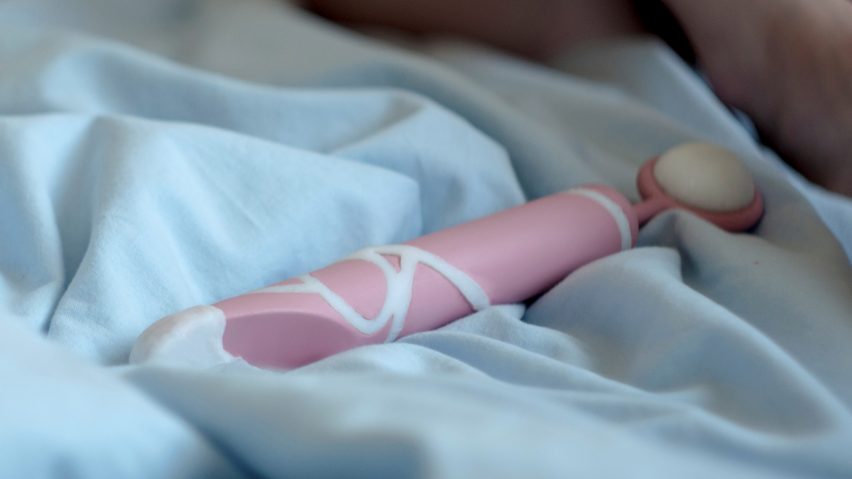Polish designer Kamila Rudnicka has created an artificial insemination tool that doubles up as a sex toy, in the hopes of restoring pleasure to an often clinical process.
Like other self-insemination aids, it allows the intimate process of conception to be carried out in the comfort and privacy of the home.
But in place of a purely functional design, the Way device draws on the same visual language as a minimalist dildo.
It is made of soft pink, medical-grade silicone with a ring at its base containing a removable bubble, which holds the semen.
"To use the device, you first need to deposit the semen into the jar that's included in the kit, and suck it into the bubble using air pressure," Rudnicka told Dezeen.
The process is reminiscent of separating an egg yolk from the white using the suction of an empty plastic bottle.
"Then the bubble goes back into the ring and needs to be connected with a tube that's wound around the hilt," the designer continued. "From there, everything works thanks to the pressure that we have in the bubble."
When the Way device is inserted into the vagina, pressing the bubble propels the semen into the uterus via these tubes.
Although they are embedded in the base of the device like veins, they can also be taken off and strapped onto the hand as a harness for insemination during manual stimulation.
"Hands are very important when we are making love, especially in lesbian sex," said Rudnicka. "That's why I decided to use them to connect two people. Just using a device will not give them the same feeling as using their own body during sex."
By integrating the device into a couple's sexual activity, the non-conceiving partner can feel like they are a part of the process, while making the process itself more pleasurable.
Far from being secondary, Rudnicka explained, this could actually be crucial to aiding fertilisation, as some studies show that orgasming could increase a woman's chances of conceiving by up to 15 per cent.
At the same time, the designer also hopes that it could eliminate the pressure and psychological stress that can be associated with repeated rounds of fertility treatments – especially when they are not immediately successful.
Because this, too can play a part in the success of conception, with one study finding that women with higher levels of stress hormones were 12 per cent less likely to conceive.
One of the women Rudnicka interviewed explained that even though the procedure of insemination in a hospital was very efficient and the doctors were trying to involve her partner, they still felt like everything was very sterile and medical.
"So I wanted to create a device that would help them focus on something other than just getting pregnant," she explained.
"In a survey I did of couples, the majority said that even if at-home insemination can be less effective they still want to try it in their own bed."
The Way device was developed in consultation with gynaecologists and psychologists, and is designed for intrauterine insemination (IUI), which sees a semen sample washed in a lab, the healthiest sperm isolated and finally injected directly into the uterus.
This is geared towards less severe fertility problems than IVF, in which an egg is removed from the ovaries and fertilised in the lab.
"This is not a device for people who have been trying to get pregnant for years," the designer explained. "It's for couples where one side has HIV, for lesbian couples, transgender people and those with disabilities – people who are unable to conceive during their regular sexual activity."
The Way device is Rudnicka's graduate project from the University of Arts in Poznań, and will need further testing before it can be used by actual couples.
"I am looking for a company that will help me to bring the product to market," she said. "The hope is to make it a 'first step' people can take before resorting to the sterile medical procedure at the hospital."
Elsewhere, Korean designer Koo Hyeonjeong has created a self-insemination device which takes the form of an enlarged Seeding Finger. Unlike the Way, it was designed primarily to facilitate women becoming pregnant by themselves, without the need for a man beyond the supply of sperm cells.
Sex toys more generally have been getting a revamp this year, with designers creating gender-neutral vibrators, one disguised as a ring and another shaped like Thomas Heatherwick's Vessel.

